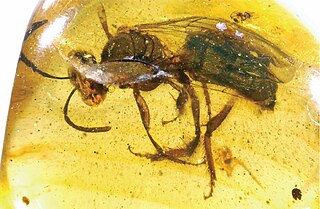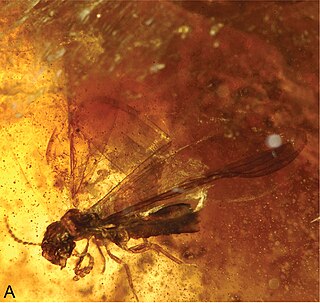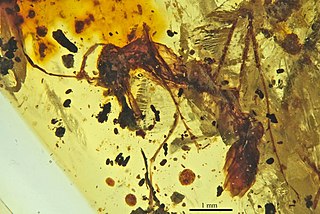
Dominican amber is amber from the Dominican Republic derived from resin of the extinct tree Hymenaea protera.

Oligochlora is an extinct genus of sweat bee in the Halictidae subfamily Halictinae. The genus currently contains six species, all of which are known from the early Miocene Burdigalian stage Dominican amber deposits on the island of Hispaniola.
Kachinus is an extinct genus of ant-like stone beetle in the family Staphylinidae containing the single species Kachinus antennatus.
Protosialis casca is an extinct species of alderfly in the Sialidae subfamily Sialinae. The species is solely known from the early Miocene, Burdigalian stage, Dominican amber deposits on the island of Hispaniola. Protosialis casca is one of only two known alderfly species present in the West Indies, the only other species is the living Protosialis bifasciata native to Cuba.

Astreptolabis is an extinct genus of earwig in the Dermaptera family Pygidicranidae known from a group of Cretaceous fossils found in Myanmar. The genus contains two described species, Astreptolabis ethirosomatia and Astreptolabis laevis and is the sole member of the subfamily Astreptolabidinae.

Nanotermes is an extinct genus of termites in the Isoptera family Termitidae known from only one Eocene fossil found in amber of the Cambay Basin. The genus contains a single described species, Nanotermes isaacae placed tentatively in the subfamily Termitinae.
Hyptia deansi is an extinct species of ensign wasp in the family Evaniidae known from a solitary Late Oligocene to Early Miocene fossil found in Mexico. H. deansi is the only species in the genus Hyptia to have been described from fossils and the only ensign wasp described from Mexican amber.
Schwenckfeldina archoica is an extinct species of dark winged fungus gnat in the family Sciaridae known from a solitary Late Oligocene to Early Miocene fossil found in Mexico. S. archoica is the only species in the genus Schwenckfeldina to have been described from fossils found in Mexican amber.
Mastotermes electromexicus is an extinct species of termite in the family Mastotermitidae known from a group of Late Oligocene to Early Miocene fossils found in Mexico. M. electromexicus is the only species in the genus Mastotermes to have been described from fossils found in Mexican amber and was the first member of the genus described from the New World. The only living species of Mastotermes is Mastotermes darwiniensis which is found in tropical regions of Northern Australia.
Termitaradus protera is an extinct species of termite bug in the family Termitaphididae known from several Late Oligocene to Early Miocene fossils found in Mexico. T. protera is the only species in the extant genus Termitaradus to have been described from fossils found in Mexican amber and is one of four species from new world amber; the others are Termitaradus avitinquilinus, Termitaradus dominicanus and Termitaradus mitnicki. T. protera was also the first termite bug described from the fossil record.
Termitaradus avitinquilinus is an extinct species of termite bug in the family Termitaphididae known from several possibly Miocene fossils found in the Dominican Republic. T. avitinquilinus is the first species in the genus Termitaradus to have been described from fossils found in Dominican amber and is one of four species from New World amber, the others being Termitaradus protera, Termitaradus dominicanus and Termitaradus mitnicki.
Anthophorula (Anthophorula) persephone is an extinct species of bee in the subfamily Apinae known from a pair of possibly Miocene fossils found on Hispaniola. A. persephone is the first species of the bee tribe Exomalopsini to have been described from fossils found in Dominican amber and is the only species of Anthophorula found in the West Indies.

Brownimecia is an extinct genus of ants, the only genus in the tribe Brownimeciini and subfamily Brownimeciinae of the Formicidae. Fossils of the identified species, Brownimecia clavata and Brownimecia inconspicua, are known from the Late Cretaceous of North America. The genus is one of several ants described from Late Cretaceous ambers of New Jersey. Brownimecia was initially placed in the subfamily Ponerinae, until it was transferred to its own subfamily in 2003; it can be distinguished from other ants due to its unusual sickle-like mandibles and other morphological features that makes this ant unique among the Formicidae. B. clavata is also small, measuring 3.43 millimetres (0.135 in), and a stinger is present in almost all of the specimens collected. The morphology of the mandibles suggest a high level of feeding specialization.
Zigrasolabis is an extinct genus of earwig in the family Labiduridae known from Cretaceous fossils found in Myanmar. The genus contains a single described species, Zigrasolabis speciosa.
Toxolabis is an extinct genus of earwig in the dermapteran family Anisolabididae known from a Cretaceous fossil found in Burma. The genus contains a single described species, Toxolabis zigrasi.
Dicromantispa moronei is an extinct species of mantidfly in the neuropteran family Mantispidae known from a fossil found in the Caribbean.
Feroseta is an extinct genus of mantidfly in the neuropteran family Mantispidae known from a fossil found in North America, and which contains a single species, Feroseta prisca.
Leptopharsa tacanae is an extinct species of lace bug in the family Tingidae. The species is solely known from the Late Oligocene to Middle Miocene Mexican amber deposits. The species is the first lace bug described from Mexican amber.

Myanmyrma is an extinct genus of ants not placed into any Formicidae subfamily. Fossils of the single known species, Myanmyrma gracilis, are known from the Middle Cretaceous of Asia. The genus is one of several ants described from Middle Cretaceous ambers of Myanmar.

Mexican amber, also known as Chiapas Amber is amber found in Mexico, created during the Early Miocene and middle Miocene epochs of the Cenozoic Era in southwestern North America. As with other ambers, a wide variety of taxa have been found as inclusions including insects and other arthropods, as well as plant fragments and epiphyllous fungi.






